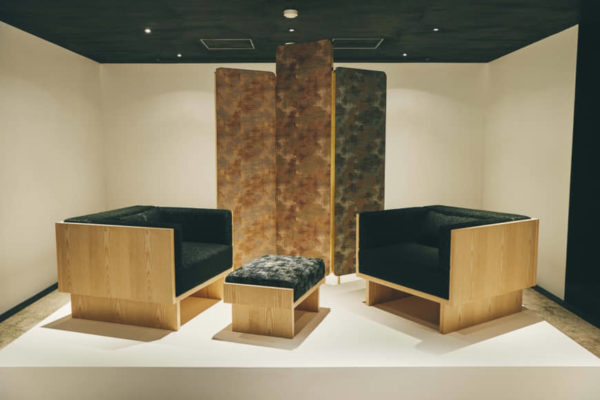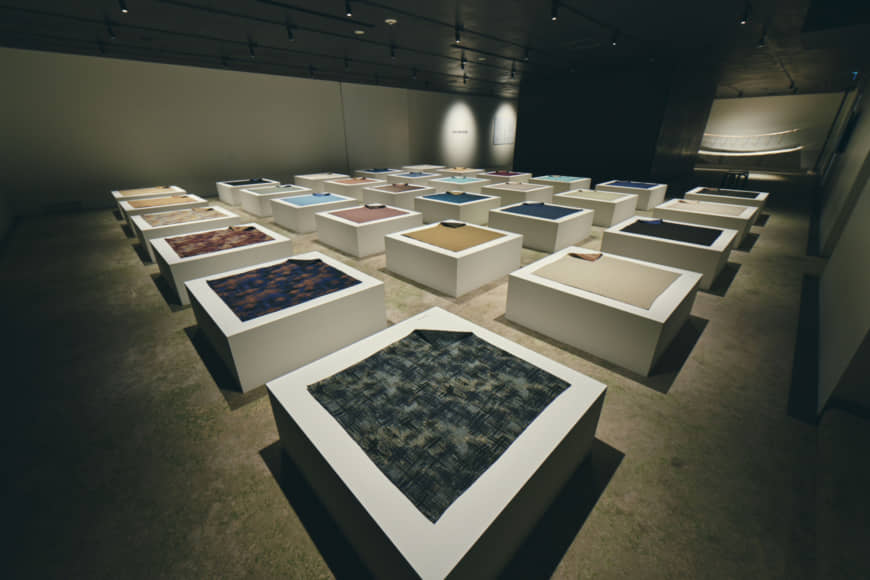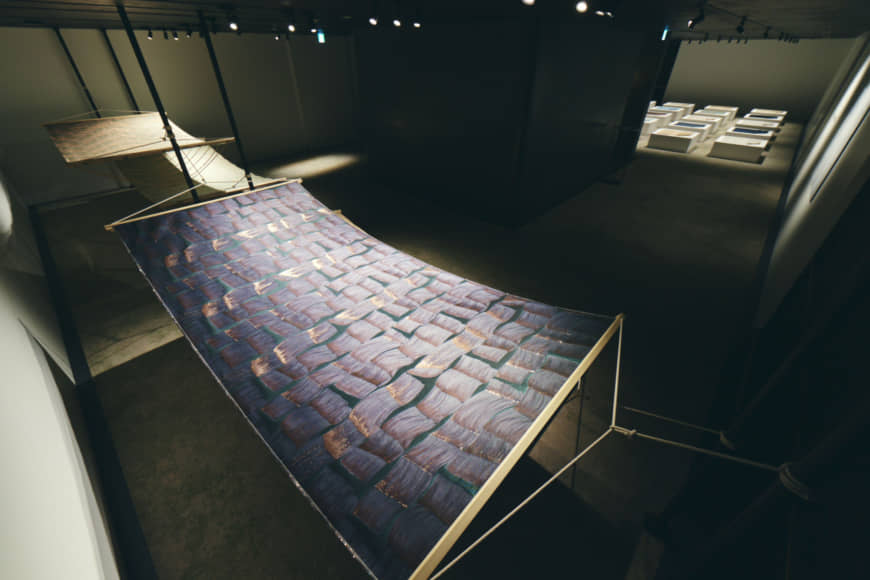A new generation Dutch textile designer with an intuitive eye for color and modern lines, and a centuries-old Kyoto company famed for its exquisitely rich kimono artisan heritage: The seemingly contrasting worlds of Holland’s Mae Engelgeer and Japan’s Hosoo have overlapped to ethereal effect in an exhibition in Kyoto exploring a nuanced spectrum of colors and textiles.
“Colortage,” the title of the show hints at its concept: a mix of “color” and “heritage.” Center stage are 30 fabrics that make up the Hosoo 2020 Collection, crafted by Nishijin (Kyoto-specific) textile artisans with color combinations directed by Engelgeer, neatly displayed on minimalist white blocks.
An installation of new textiles, designed by Engelgeer during Hosoo’s first artist-in-residence program last summer, are also festooned on traditional bamboo displays known as shinshi.
There are few more appropriate settings for such a collaboration than Hosoo Gallery, located in the Hosoo Flagship Store, which opened on a quiet lane in Kyoto’s central Karasuma Oike district last autumn.
Hosoo is a shining example of a traditional Kyoto artisan company that is thriving in contemporary times. Founded in 1688, the textile company has been steered by 12th-generation Masataka Hosoo for the past 12 years — and he has navigated a measured balance between maintaining its traditional craftsmanship roots and forging an innovative path into the future.
Pushing a raft of creative boundaries, projects (among many others) include creating bespoke Nishijin fashion textiles for luxury clients such as Chanel and Dior; gallery installations inspired by filmmaker David Lynch; a recent 3D-effect collection of modern sashiko-ori (pattern stitched) textiles with designer Nendo; furniture collections with Copenhagen-based OEO Studio; plus regular exhibits at global design events including Milan’s Salone del Mobile.

The five-level Hosoo Flagship store confirms a contemporary spirit rooted in heritage (it’s also home to a lounge, a lifestyle boutique and a “kimono cellar”). Designed by architect Naohisa Hosoo (Masataka’s brother), it’s a textbook-perfect showcase of 21st-century Kyoto architecture, from its signature rammed-earth walls in layered shades of peach and clean-lined OEO Studio seating to the smooth expanses of ink-black dyed plaster sliced with delicate gold lines. Its second-floor houses Hosoo Gallery, home to “Colortage.”
“One of the main reasons to open a gallery space was to provide an opportunity for the general public to learn about the history and characteristics of traditional Japanese dyeing and weaving that have been passed down from generation to generation,” Hosoo explains. “It is important for us in the dyeing and weaving industry to pass this knowledge and know-how to generations to come. We also want to stimulate discussions on concepts of ‘beauty’ and ultimately ‘what it is to be human.’”
“Colortage” is an example of this. It was during Engelgeer’s first trip to Japan in 2015 that her path first crossed with Hosoo when she visited the Kyoto store with an architect contact.
“The first time I set foot in the showroom and talked with Hosoo, I dreamed of working with them,” she says. “I felt so impressed by the heritage and the special look of the fabrics.”
After an initial collaboration working on Hosoo’s 2017 Collection, the partnership deepened last year, when Engelgeer art directed colors for its new 2020 Collection. Furthermore, as Hosoo’s first artist-in-residence, she spent a month creating new textile designs while staying in the company’s beautifully renovated machiya townhouse House of Hosoo.

The fruits of the collaboration evolved into “Colortage.” Here, visitors can see at firsthand — and even touch — textiles from Hosoo’s 2020 Collection. Thirty low-level white blocks individually showcase the colored fabrics, with each row depicting one single design in six different shades. The textiles — some glistening sharply, others blurred to abstraction — feel as clean and modern as the quality is luxuriously rich in craftsmanship.
Among them, are “Hash” in ivory cream, with its grid-like sheaves of effervescent gold; “Haze” in an ethereal blue with subtly sparkling sky blue threads; and “Fizz,” in silver gray, with delicately flowing lines catching the light.
“We really give the focus to the overall feel and color experience with these display blocks,” says Engelgeer. “People can constantly see the textiles and the combination from a different perspective and also zoom in on a single fabric and explore the backsides, which are also special.”
She adds, “From what I have heard, I was the first designer to really work this closely with their artisans. I am extremely happy to have had the opportunity to stand next to the machines while weaving, discussing what we see happening and adjusting in the moment. As a designer I am always keen to see the production place, talk to weavers and be involved from the start.”

The hammock-like displays of textiles for the “Sinuous” installation — created during her residency — are no less eye-catching. Inspired by patterns hand-drawn by Kyoto artisans, the four textiles fuse Engelgeer’s contemporary designs with soft hues — resulting in delicately nuanced shades of peaches and silvers perfectly aligned with organically flowing curves and brush-stroke motifs.
“Our approach has always been more focused on structure. We use sakizome (pre-dyed yarn) technique. But usually, we’d focus on one textile and work on it starting from the weave pattern,” Hosoo says, commenting on working with Engelgeer’s “incredible sense of color” mixed with a “feminine quality.”
“This time, from the construction of each thread, we’ve incorporated the color scheme into the process. This was our first time using this approach, so working with Mae was very important,” he adds. “She introduced a unique approach that had not existed in Nishijin heritage until now.”
The exhibition appears to consolidate the bold new direction Hosoo is embracing as it moves forward.
“The incorporation of new ideas through collaborations with contemporary designers is an important step towards innovation and development,” says Hosoo. “It provides us with new perspectives and opportunities that add to our traditions, encouraging change and benefiting us for the next 100 to 200 years to come. In a sense, change itself continues traditions.”
“Colortage” at Hosoo Gallery, at Hosoo Flagship Store in Kyoto, runs through April 11 and is free to view. For more information, visit www.hosoo-kyoto.com.




